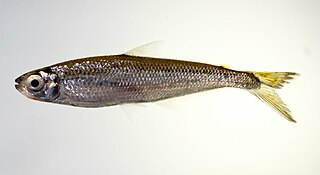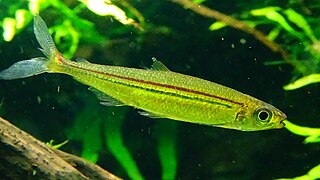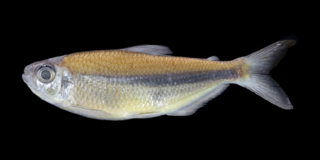
Bryconops is a genus of freshwater fish in the family Iguanodectidae from South America. It consists of small fish, all under half-a-foot long, with slender bodies and silvery scales, though there is some mild color variation. Several species can be identified by way of a humeral patch, and others have a reddish ocellus, or eyespot, on one or both lobes of the dorsal fin.

Iguanodectes is a genus of freshwater fish found in tropical South America, with eight currently described species. They are all small tetras, none longer than 5 inches, and often have attractive silvery or striped scales, which makes them a target for the ornamental fish industry. Alongside the genus Piabucus, it is in the subfamily Iguanodectinae, which in turn is in the family Iguanodectidae. The genus Bryconops, which is also in Iguanodectidae, makes up a sister clade to Iguanodectinae.

Piabucus is a genus of freshwater tetras in the family Iguanodectidae. All three species are found in South America, largely the Amazon and its major tributaries. None of them are longer than half a foot long, with the largest reaching a maximum size of 12.9 cm (5.1 in), and they are slender, with relatively deep chests and long pectoral fins. Their scales are pale or silvery, with lateral lines that stand out.

Iguanodectinae is a subfamily of small freshwater fish in the family Iguanodectidae. They are most prominently found in the Amazon river basin and its major tributaries, but they are also known from the Tocantins, Orinoco, and Paraguay rivers. It has two genera, Piabucus and Iguanodectes. Some species in the subfamily are taken from the wild for aquariums, like the red- and green-line lizard tetras. There is minor, but ongoing, debate regarding its taxonomy.

Bryconops alburnoides is a small freshwater fish, approximately 6 inches long at its largest, that lives in the rivers of South America. It has a slender body, with a yellowish dorsal fin and yellow-tinged back scales that fade into silver on its belly. It is largely an insectivore that picks land-dwelling insects from the riverbanks, though it eats much more whenever rain washes prey into the water.

The tailspot tetra is a freshwater fish that lives in the coastal river regions of upper South America. Both its common and scientific names reference the distinct spot of color present on the tail fin, which is one of its defining characteristics. It is a small fish, reaching 4.8 in at its longest. Despite its small size, it is an active swimmer, with a preference for fast-flowing waters.
Bryconops colanegra is a small, slender-bodied species of freshwater fish from South America, about 3.5 in long. It has a black tail fin that bears hints of red, and its scales are dark along the back, transitioning to a silver belly. It is endemic to a single river system in Venezuela, the Rio Caroní.

Bryconops colaroja is a small species of fish endemic to tributaries and creeks of the Cuyuni River basin in Venezuela. The specific epithet "colaroja" means "red tailed", and it gets this name from its most distinctive feature - a deep red caudal fin, largely unique amongst members of its genus.

Bryconops collettei is a small freshwater fish from the rivers of South America. It is mostly silvery, with notable green iridescence on its sides, and a diffuse ocellus (eyespot) on the upper lobe of the caudal fin. Before its distinction as a separate species, specimens of B. collettei were misidentified as specimens of Bryconops caudomaculatus due to several morphological similarities, including a caudal ocellus and generally similar fin coloration.
Bryconops disruptus is a small freshwater fish of the family Iguanodectidae. It is only found in the Rio Negro in South America. Like the rest of the genus Bryconops, B. disruptus is silvery in color, with a relatively deep chest and a notable set of teeth. The specific epithet "disruptus" refers to the incomplete lateral line.
Bryconops durbinae, sometimes listed under the name Bryconops durbini, is a small species of freshwater fish in the family Iguanodectidae. It is the smallest species of the genus Bryconops, and is endemic to the Tapajós river basin in Brazil.
Bryconops inpai is a small freshwater fish native to the rivers of South America. It only lives in two particular river systems - the Casiquiare and Negro - which means that its range is restricted to the northern half of the continent. It has indistinct humeral spots, and is bluish-silver in life, which is unusual for members of Bryconops; they are more often plain silver or greenish-silver.

Bryconops magoi is a small species of fish from South America. It is only found in Venezuela, along with sister species Bryconops collettei. Its tail-fin markings help to differentiate it from various congeners, as does its fairly restricted range. It is most closely related to B. collettei and Bryconops caudomaculatus, and it was once considered synonymous with the latter; specimens of B. magoi and B. collettei both were routinely misidentified as B. caudomaculatus before being given species distinction.
Bryconops vibex is a small freshwater fish from the rivers of Venezuela, known solely from the Rio Cataniapo. The body is slender, though with an element of sturdiness, and it has one humeral spot by each pectoral fin. It bears visual similarities to several congeners, but can be differentiated by way of many factors.

Bryconops florenceae is a small freshwater fish that inhabits the rivers of South America. Comprehensive research is lacking due to B. florenceae being the most recently described of the genus, but researchers believe it to be a relatively widespread species. It is found throughout the Maroni, Mana, and Sinnamary river basins, which defines its range within Suriname and French Guiana.

Iguanodectes geisleri, the red-line lizard tetra, is a species of freshwater fish from South America. It is a small species, largely herbivorous with some omnivorous traits, that prefers to live in schools and is partial to shallow waters, especially in blackwater habitats. Some aspects of its body plan are unique amongst its genus, including the position and length of the anal fin.
Iguanodectes gracilis is a small species of freshwater fish from South America. It is known solely from the Rio Negro river system, which restricts its range only to Brazil. The name "gracilis" is in reference to a slender body shape, alongside the diminutive nature of I. gracilis - it is the smallest member of the genus Iguanodectes.
Iguanodectes spilurus, the green-line lizard tetra, is a small characiform fish from the rivers of South America. It is not a well-studied species, but research is available, including data from hobbyists that keep it as an ornamental fish. It has a distinct lateral stripe of reflective-green scales, and lacks any red markings therein; red is common in congeners' lateral stripes.
Iguanodectes variatus is a small freshwater fish, described from the rivers of South America in 1993. It has a minor presence in the aquarium trade, but lacks the popularity that would make excessive wild capture a legitimate threat. That being said, the threats facing South American aquatic environments are of ongoing concern for the associated biodiversity. Still, I. variatus has been recorded from various rivers and has shown general adaptability to its environment, which speaks to a high survivability.
Piabucus caudomaculatus is a small freshwater fish inhabiting the rivers of South America. It was the first member of the family Iguanodectidae to be reported from Bolivia, and it remains endemic to the region, found solely in the Mamoré river basin. It displays a preference for slow-moving waterways and has a largely insectivorous diet.









